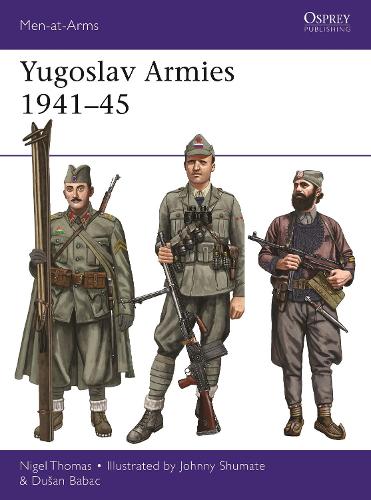
Yugoslav Armies 194145
(Paperback)
Publishing Details
Yugoslav Armies 194145
By (Author) Nigel Thomas
By (author) Dusan Babac
Illustrated by Johnny Shumate
Bloomsbury Publishing PLC
Osprey Publishing
1st March 2022
20th January 2022
United Kingdom
Classifications
General
Non Fiction
Second World War
Military uniforms / insignia
940.542197
Physical Properties
Paperback
48
Width 184mm, Height 248mm
168g
Description
In March 1941, an anti-German coup in the Kingdom of Yugoslavia prompted Hitler to order an invasion using allied Italian, Hungarian, Bulgarian and Romanian forces. Operation Marita was an invasion of Yugoslavia and simultaneously Greece. At the same time, the constituent region of Croatia broke away from Yugoslavia and joined the Axis powers. Royal Yugoslav armed forces, despite advancing against the Italians in Albania were forced to surrender after 11 days' fighting and some 1,000 soldiers, airmen and sailors escaped to British-occupied Egypt to form Free Yugoslav units. From there, guerrilla resistance to the Axis occupiers broke out and continued with increasing strength until the end of the war under Mihailovics royalist 'Chetniks' and Tito's Communist 'Partisans' (both supported by Britain). However, hostilities between the two movements eventually led to the Chetniks entering into local agreements with Italian occupation forces and Britain switching its support entirely to the Partisans. The advance of the Red Army increased Partisan strength and, during 194445, they created what could be described as a lightly equipped conventional army. Using meticulously-drawn illustrations of different insignia, uniforms and equipment from each faction to bring the conflict alive, this volume describes, in detail, both the political and military implications of the war and how it was fought, setting the scene for the subsequent rise of Tito to power within Yugoslavia.
Author Bio
DR NIGEL THOMAS is an accomplished linguist and military historian, formerly at Northumbria University, now a freelance military author, translator and military uniform consultant. His interests are 20th-century military and civil uniformed organizations, with a special interest in Germany, Central and Eastern Europe. He has written widely for Osprey with titles such as MAA 518 Polish Legions 191419 and Elite 227 Armies of the Baltic Independence Wars 191820.He was awarded a PhD for the study of the Eastern enlargement of NATO. Duan Babac was born and lives in Belgrade. He has a degree in Engineering from Belgrade University and is the Director of the Royal Palace Foundation there. He is also an associate of the Belgrade Military Museum and the Serbian History Museum. He is the renowned author and co-author of more than 25 books on the military history of Serbia, Montenegro and Yugoslavia, and has published many articles in Serbian, Russian and French military magazines. He also acts as a uniform consultant for Serbian film and theatrical productions.
